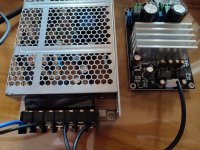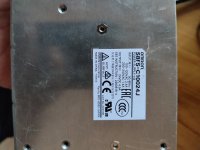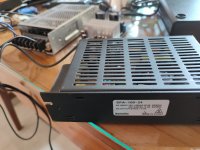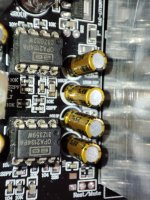experience:
If you listened with an op amp, you can hear it in good stereo stage with the speakers line. If I listen without an op amp — with an impedance- adapter — the music detaches from the speakers in advance, and the stage image is dizzying.
Experience: It is important to have a well-chosen psu. the output of smps does not require large capacity, it is worth making several small values. The use of the 1uF 100v Siemens B32650 Polyester Capacitors shows good results.
If you listened with an op amp, you can hear it in good stereo stage with the speakers line. If I listen without an op amp — with an impedance- adapter — the music detaches from the speakers in advance, and the stage image is dizzying.
Experience: It is important to have a well-chosen psu. the output of smps does not require large capacity, it is worth making several small values. The use of the 1uF 100v Siemens B32650 Polyester Capacitors shows good results.
Hi.I just received the "deluxe" version of this amp with the LME49720NA op-amps, Nichicon FW 2200uF/63v caps and Wima caps. I measured the height of the Nichicon caps and they are 35 mm. My "basic" version amp has 30 mm high caps.
Could you please tell me what Wima capacitors they put in? Is their value always a 1uF?
Last edited:
Good afternoon,
I recently purchased a Shui Yuan Audio TPA3255 (about €30)
It will be installed in the
Klipsch R-41M (50W rms / 100W peak per channel)
What font do you recommend? (I noticed they use this in some configurations https://www.banggood.com/Geekcreit-...-p-1111658.html?cur_warehouse=CN&rmmds=search )
I can solder components easily. Is there any modification you recommend? (a good cost-benefit difference is noted)
Thanks a lot for the help
I recently purchased a Shui Yuan Audio TPA3255 (about €30)
It will be installed in the
Klipsch R-41M (50W rms / 100W peak per channel)
What font do you recommend? (I noticed they use this in some configurations https://www.banggood.com/Geekcreit-...-p-1111658.html?cur_warehouse=CN&rmmds=search )
I can solder components easily. Is there any modification you recommend? (a good cost-benefit difference is noted)
Thanks a lot for the help
Hi! This is my first post in thread. I'm from Hungary, and I'm thinking buying a Shui Yuan Audio TPA3255 panel. I'd like modify a little bit (capacitor change, maybe opamp and inductor change to better). What is your opinion, can I reach with these modifications the Jlester or other more expensive board's sonic quality, or worth buying the expensive boards without mods?
I'd like use this SMPS: https://www.aliexpress.com/item/323...1;27.43;-1;-1@salePrice;USD;search-mainSearch
Opinion?
Thanks for help!
I'd like use this SMPS: https://www.aliexpress.com/item/323...1;27.43;-1;-1@salePrice;USD;search-mainSearch
Opinion?
Thanks for help!
Trying my board for the först time and both led are lit,should they be?
Both channels are playing
Both channels are playing
Trying my board for the först time and both led are lit,should they be?
Both channels are playing
Normal!
That SMPS looked interesting until I noticed it needs 230 VAC input. Is that a common voltage in Hungary?Hi! This is my first post in thread. I'm from Hungary, and I'm thinking buying a Shui Yuan Audio TPA3255 panel. I'd like modify a little bit (capacitor change, maybe opamp and inductor change to better). What is your opinion, can I reach with these modifications the Jlester or other more expensive board's sonic quality, or worth buying the expensive boards without mods?
I'd like use this SMPS: https://www.aliexpress.com/item/32377749984.html?spm=a2g0o.productlist.0.0.3a1042b9fNbPdy&algo_pvid=4131e51c-d6f7-47b3-871e-cbb7dbb7932f&algo_exp_id=4131e51c-d6f7-47b3-871e-cbb7dbb7932f-15&pdp_ext_f={"sku_id":"65274482891"}&pdp_pi=-1;27.43;-1;-1@salePrice;USD;search-mainSearch
Opinion?
Thanks for help!
Yes. I seen very similar PSU in this product: https://www.aliexpress.com/item/1005003702029950.html?spm=a2g0o.cart.0.0.77f33c006PWkUY&mp=1 + my buddy have good experience with this.That SMPS looked interesting until I noticed it needs 230 VAC input. Is that a common voltage in Hungary?
Input voltage: AC100~264VAC
I do not recommend these cheap Psu. The switching frequency is too low, the ripple at the output is high. These are very difficult to reduce in retrospect. These appear as noise in the music. Cover up real "information" It's worth sacrificing more on a medical Meanwill or Connax power supply.
i experimented a lot with upgrading cheap psu with very few results.
i experimented a lot with upgrading cheap psu with very few results.
Last edited:
Thanks for help!I do not recommend these cheap Psu. The switching frequency is too low, the ripple at the output is high. These are very difficult to reduce in retrospect. These appear as noise in the music. Cover up real "information" It's worth sacrificing more on a medical Meanwill or Connax power supply
I do not recommend these cheap Psu. The switching frequency is too low, the ripple at the output is high. These are very difficult to reduce in retrospect. These appear as noise in the music. Cover up real "information" It's worth sacrificing more on a medical Meanwill or Connax power supply.
i experimented a lot with upgrading cheap psu with very few results.
I totally agree . Meanwell or Mornsun ...
Taking modding of the Shui Yuan aka Joepie China board to a new level. I needed a PBTL TPA3255 board to replace my blown STA517B amp. Unfortunately I only found this stereo BTL board. Alternatives were prohibitingly more expensive. I already had decided on the schematic:
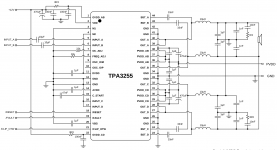
so I only needed the board's schematic. As I did not find it I hand drew it:
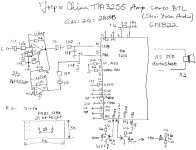
Because this amp is used in a special configuration and driven from the balanced output of my subwoofer filter amp I could remove both ICs at the input. I also placed the TPA into PBTL mode by lifting pin #4 (M2) and attaching it to +3 V (DVDD):
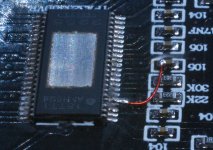
This was a horrible mod... The wire is only 0.2 mm thick but I got it done at the first attempt. Put some tape over it to prevent it shorting out to the heatsink.
The input was next. For PBTL operation inputs C and D must be grounded:
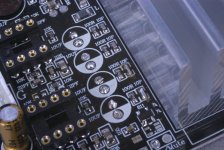
The outputs must be paralleled. The "official" way is to do that at the chip's outputs but as the leads are way too tiny to do that reliably so I opted to do that after the inductors:
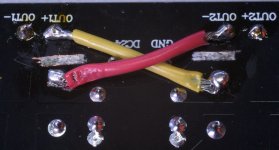
The terminal blocks were replaced by AMP 1/4" spades because the speaker already used them:
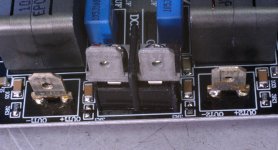
I tested the amp with 48 V and in a 4 ohm load it gets so hot it goes into thermal protect after some time. Power is about 200 W but input power is 220 W so the heatsink has to dissipate about 20 W. Either it is too small or the paralleling is not going perfectly well. As efficiency of the TPA is 90% I think it is the former and that mykludgemod is valid.

so I only needed the board's schematic. As I did not find it I hand drew it:

Because this amp is used in a special configuration and driven from the balanced output of my subwoofer filter amp I could remove both ICs at the input. I also placed the TPA into PBTL mode by lifting pin #4 (M2) and attaching it to +3 V (DVDD):

This was a horrible mod... The wire is only 0.2 mm thick but I got it done at the first attempt. Put some tape over it to prevent it shorting out to the heatsink.
The input was next. For PBTL operation inputs C and D must be grounded:

The outputs must be paralleled. The "official" way is to do that at the chip's outputs but as the leads are way too tiny to do that reliably so I opted to do that after the inductors:

The terminal blocks were replaced by AMP 1/4" spades because the speaker already used them:

I tested the amp with 48 V and in a 4 ohm load it gets so hot it goes into thermal protect after some time. Power is about 200 W but input power is 220 W so the heatsink has to dissipate about 20 W. Either it is too small or the paralleling is not going perfectly well. As efficiency of the TPA is 90% I think it is the former and that my
which is better?Have done an long three months listening at Shui Yuan Audio crossed at 3500khz in my active two way.
Sounds good but when I mounted back my 3e-audio TPA3255 it's pretty clear what is better.
So, except for a handheld oscilloscope reading, I've seen practically no measurements. Is there a reason people do not measure? In any case, I have a version similar to the Shui Yuan but they have cheap ceramic caps under the TPA3255 that broke off on 3 of the 4 boards. Good riddance. I'll just replace them all. These boards call for 1uF called for (105 instead of the smaller values seen on the Shui Yuan). So, until I get those ordered and in, I won't be able to test those.
I also have 4x3E audio ones as well. I also bought a Rigol MSO, so in the next couple weeks or month (depending on work and time outside in the garage building my boxes) I should have some test data to actually show the FFTs over the frequency. Still a noob, just a noob with equipment to tell what I am seeing/hearing.
I'm using 1 cheap and 1 3E in each speaker, in a 3-way configuration. Two channels will be driven by the 3E, 1 channel driven by the cheaper amp module. I'm also replacing the heatsink with a 3"x2"x1" block of aluminum that will be attached to an aluminum plate, with an aluminum heatsink measuring 2.5" fin depth 10.08"x5". By my calculations, that should be able to keep the TPA3255 well under the 125C Tjunc temp (possibly as low as 60C, but there are losses because of the heat soak to the aluminum block mass, etc.).
Everyone here is primarily focused on the components forgetting that heat effects drastically the performance of components. You can meet spec, which arguably these heatsinks do, or you can do something that will allow you to be well under spec. Even heat on caps can drastically change their performance in the audible frequencies, which is why some datasheets include the information on heat relative to frequency.
Regardless, you would need the FFT functionality on an oscilloscope (basically a spectrum analyzer) in order to see if the changes are happening within the audible frequency, whether that means changing noise floor or moving something to a frequency well above human hearing thresholds). You would need a consistent low noise power supply to test the amps, while also needing to test the noise and noise filtering on the power supplies to be integrated. Only after all of this can you truly check the effects on the output of the amps, rather than just rolling components to higher quality components.
In fact, if people just want to do that, you might as well create a self-solder kit and pocket the difference on the bulk order of components, or just make a blank board for people to populate as a hobby.
My point is, with all the hundreds to thousands of dollars on audio equipment, I kind of feel people would have all the test equipment to find a definitive answer, from oscilloscopes to calibrated mics to SPL meters to signal generators, etc.
BTW, I'm doing an Arylic Up2Stream Pro V3 to a SPDIF on a chinese made DSP with an ADI ADSP-21489, while also using the Arylic for the pass through external audio to control the volume, which feeds into the DSP's ADC which is a Burr Brown PCM4202, while the DACs on it are the Burr Brown PCM1798s. Those will feed out to the amplifier's individual channels, which then powers per speaker in the 3-way. I'm going to replace the mid-woofer, so don't give me crap about the current choice. I have Scanspeak 30W/4558T00 for the sub, SEAS U18RNX-P for the mid-woofer, and the SEAS 27TAC/GBs. This is a full active speaker with a 1000W 48V DC power supply for the amplifiers, then separate power supplies for each the Arylic and the DSP.
Depending on the noise, I'll replace the op amps on the ADC and DAC boards first, as they are MC33078 with a THD+N of 0.002%. Although this matches that of the TPA3255, it begs the question when the OPA1678 is a drop in replacement (trouble is finding them). The THD+N of the OPA1678 is 0.00035%, which is much lower than what is currently on there.
I'll post what I find on the boards. If anyone has the minimum voltage for the caps under the TPA3255, I'd be greatly appreciative. I just have not compared their (edit: meaning TI's) circuit diagram (edit: for the TPA3255) yet.
Also, please test more people, meaning generate objective data. Objective numbers go a far way in helping to understand what we hear and what sounds good. Otherwise, we may loose something due to sense. See Of Sense and Reference by Frege ( discussing how even though we use the same words, what they mean to us may vary person to person; so we may have the same reference, a fixed object, a measurement, etc., but when we ascribe meaning or sense to the reference, we may describe it differently, and that can mean that we are not able to truly convey meaning to another person if we cannot agree how to talk and discuss such things).
I also have 4x3E audio ones as well. I also bought a Rigol MSO, so in the next couple weeks or month (depending on work and time outside in the garage building my boxes) I should have some test data to actually show the FFTs over the frequency. Still a noob, just a noob with equipment to tell what I am seeing/hearing.
I'm using 1 cheap and 1 3E in each speaker, in a 3-way configuration. Two channels will be driven by the 3E, 1 channel driven by the cheaper amp module. I'm also replacing the heatsink with a 3"x2"x1" block of aluminum that will be attached to an aluminum plate, with an aluminum heatsink measuring 2.5" fin depth 10.08"x5". By my calculations, that should be able to keep the TPA3255 well under the 125C Tjunc temp (possibly as low as 60C, but there are losses because of the heat soak to the aluminum block mass, etc.).
Everyone here is primarily focused on the components forgetting that heat effects drastically the performance of components. You can meet spec, which arguably these heatsinks do, or you can do something that will allow you to be well under spec. Even heat on caps can drastically change their performance in the audible frequencies, which is why some datasheets include the information on heat relative to frequency.
Regardless, you would need the FFT functionality on an oscilloscope (basically a spectrum analyzer) in order to see if the changes are happening within the audible frequency, whether that means changing noise floor or moving something to a frequency well above human hearing thresholds). You would need a consistent low noise power supply to test the amps, while also needing to test the noise and noise filtering on the power supplies to be integrated. Only after all of this can you truly check the effects on the output of the amps, rather than just rolling components to higher quality components.
In fact, if people just want to do that, you might as well create a self-solder kit and pocket the difference on the bulk order of components, or just make a blank board for people to populate as a hobby.
My point is, with all the hundreds to thousands of dollars on audio equipment, I kind of feel people would have all the test equipment to find a definitive answer, from oscilloscopes to calibrated mics to SPL meters to signal generators, etc.
BTW, I'm doing an Arylic Up2Stream Pro V3 to a SPDIF on a chinese made DSP with an ADI ADSP-21489, while also using the Arylic for the pass through external audio to control the volume, which feeds into the DSP's ADC which is a Burr Brown PCM4202, while the DACs on it are the Burr Brown PCM1798s. Those will feed out to the amplifier's individual channels, which then powers per speaker in the 3-way. I'm going to replace the mid-woofer, so don't give me crap about the current choice. I have Scanspeak 30W/4558T00 for the sub, SEAS U18RNX-P for the mid-woofer, and the SEAS 27TAC/GBs. This is a full active speaker with a 1000W 48V DC power supply for the amplifiers, then separate power supplies for each the Arylic and the DSP.
Depending on the noise, I'll replace the op amps on the ADC and DAC boards first, as they are MC33078 with a THD+N of 0.002%. Although this matches that of the TPA3255, it begs the question when the OPA1678 is a drop in replacement (trouble is finding them). The THD+N of the OPA1678 is 0.00035%, which is much lower than what is currently on there.
I'll post what I find on the boards. If anyone has the minimum voltage for the caps under the TPA3255, I'd be greatly appreciative. I just have not compared their (edit: meaning TI's) circuit diagram (edit: for the TPA3255) yet.
Also, please test more people, meaning generate objective data. Objective numbers go a far way in helping to understand what we hear and what sounds good. Otherwise, we may loose something due to sense. See Of Sense and Reference by Frege ( discussing how even though we use the same words, what they mean to us may vary person to person; so we may have the same reference, a fixed object, a measurement, etc., but when we ascribe meaning or sense to the reference, we may describe it differently, and that can mean that we are not able to truly convey meaning to another person if we cannot agree how to talk and discuss such things).
Last edited:
I just received Shui Yuan TPA3255. It's cost around $29 including the shipping cost and tax to Indonesia
I tried to power up the amplifier with SMPS power supply : Omron S8FS-C10024 (24v 4.5A) and after 1 hour then I try to switch with Autonics SPA-100-24(24v 4.2A).
I'm not sure why the fault LED and clip LED always light on. Is it normal?
With Omron, I set the voltage from 22.5 up to 28.5v and I can hear the difference when the voltage changed. Higher voltage will give wider soundstage. then I try to switch the power supply with Autonics, and I can hear the difference with Omron. The lower sound, the bass is little bit punchy with Autonics.. maybe the Autonics output has less noise? I don't have any tools to measure the ripple so I'm not sure why Autonics sound better.
After listening 2-3 hour, I can say this 'raw' unmodified version sounds better than some Chinese TPA3116 board I ever heard. I also have myRefC amp (class AB) with boutique components, FH9 (class AB) , FX8 amp (class A) and this TPA3255 amp sound so good in my ear.
I have OPA2134 to test. after rolling the op amp, this amplifier sound more pleasant, more 'musical' to my ears
I tried to power up the amplifier with SMPS power supply : Omron S8FS-C10024 (24v 4.5A) and after 1 hour then I try to switch with Autonics SPA-100-24(24v 4.2A).
I'm not sure why the fault LED and clip LED always light on. Is it normal?
With Omron, I set the voltage from 22.5 up to 28.5v and I can hear the difference when the voltage changed. Higher voltage will give wider soundstage. then I try to switch the power supply with Autonics, and I can hear the difference with Omron. The lower sound, the bass is little bit punchy with Autonics.. maybe the Autonics output has less noise? I don't have any tools to measure the ripple so I'm not sure why Autonics sound better.
After listening 2-3 hour, I can say this 'raw' unmodified version sounds better than some Chinese TPA3116 board I ever heard. I also have myRefC amp (class AB) with boutique components, FH9 (class AB) , FX8 amp (class A) and this TPA3255 amp sound so good in my ear.
I have OPA2134 to test. after rolling the op amp, this amplifier sound more pleasant, more 'musical' to my ears
Attachments
- Home
- Amplifiers
- Class D
- Shui Yuan Audio TPA3255 Modification Thread
